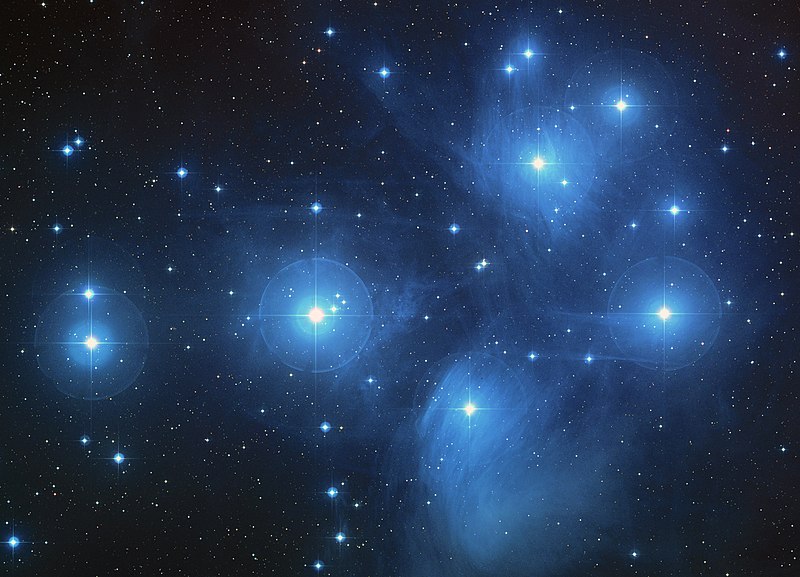TWH – As the December solstice approaches, many familiar constellations appear in the night skies. Among these constellations are Orion the Hunter and the Seven Sisters, often called the Pleiades. Two Australian scientists have speculated that this constellation pair is the inspiration for the oldest legend of humankind that may date to 100,000 years ago.
The research is published in a new edited volume titled, Advancing Cultural Astronomy. The interdisciplinary field of cultural astronomy, or astronomy in culture, investigates the diversity of ways modern and ancient cultures perceive and interpret celestial objects and integrate them into their worldview.
Dr. Kate Magargal, a Postdoctoral Research Associate in the University of Utah Anthropology Department, writing for the Dark Sky Cooperative noted that, “Cultural astronomy, through the exploration of archaeology and traditional knowledge, offers an avenue for exploring the broad scope of ideas, discoveries, and inspirations the night has informed over the course of human history and prehistory.”
The Pleiades are described in numerous cultures, however. The Celts called them Tŵr Tewdw, the Persians, Hindi and Urdu called them Parvī, to the Hawaiians, they are Makaliʻi, the Māori called them Matariki, they are the Subaru in Japanese and in Hinduism, they are the Krittika. Aboriginal Australians, Chinese, Cherokee, Maya, Aztecs, Sioux among others, all identify the constellation. They are mentioned in Amos 5:8; Job 9:9; and Job 38:31 in the Bible.

The Pleiades [public domain: NASA]
The new research focuses on the Pleiades, specifically, also called Messier 45 by astronomers. As readers may recall, the Pleiades get their name from Greek mythology. The sisters are companions of Artemis and daughters of the titan, Atlas, and the sea-nymph, Pleione.
The constellation may have been particularly important in the Mediterranean, as its annual appearance marked the start of the regional sailing season. The name Pleiades may be related to the ancient Greek word for “to sail.”
In the Greek myth, Orion the hunter pursued the Pleiades with sexual intentions. To save the sisters, Zeus transformed them into doves and later into the stars, where they would remain to comfort their father who held up the earth and the heavens.
Interestingly, the Aboriginal cultures of Australia also describe the constellation as a hunter – called the saucepan – pursuing a group of young girls with sexual intent. The constellation is an important part of Aboriginal calendars and is associated with sacred women’s mysteries and ceremonies.
In both stories, there are seven sisters, six are visible and one is hiding or missing. There are similar references to a missing sister in African, Asian, European, Indonesian, and Native American cultures.
The Greek poet Aratus of Soli gave the Pleiades their names: Halcyone, Merope, Celaeno, Electra, Sterope, Taygete, and Maia; but also noted that only six were visible. Among the Iroquois, one of the stars sang and became fainter. And in Islam, one fell and became the Great Mosque.
But, if you look at this constellation this evening, even under the darkest skies, it is likely that you will only see six stars. Even the keenest eyes have trouble making out additional stars without optical assistance. There are some individuals who can make out more stars with the naked eye, but it was Galileo Galilei who first viewed the Pleiades through a telescope and recorded 36 stars in his treatise on the constellation in 1610.
In the new research, astrophysicists Dr. Ray P. Norris and Dr. Barnaby R.M. Norris ask two central questions: “First, why are the mythological stories surrounding [the Pleiades], typically involving seven young girls being chased by a man associated with the constellation Orion, so similar in vastly separated cultures, such as the Australian Aboriginal cultures and Greek mythology? Second, why do most cultures call them “Seven Sisters” even though most people with good eyesight see only six stars?”
The questions are especially compelling because our ancestors who migrated out of Africa separated around 100,000 BCE into groups that would become European and Aboriginal Australian cultures. The groups would have no contact until the British invaded Australia in 1788 CE.
The researchers explore how the variability of the light of some of the stars in the Pleiades and their glare and perceived distance to one another may explain that one of the stars was much brighter in the past.
The researchers focused on the star, Pleione, as the candidate for the seventh star. Pleione is hard to see and so close to the star, Atlas, that it will appear as a single star to the naked eye. Or perhaps better said, that’s how they appear today.

The simulated visual appearance of Atlas and Pleione at the current epoch and at 100,000 BC. [via Ray Norris]
The researchers then used data to simulate the appearance of these two stars in the past. While the stars appear merged now, they would have appeared as blurred but separate stars 100,000 years ago.
The researchers conclude that the similarity of stories across cultures of a seventh star in an obvious constellation in the heavens is because a seventh star was visible. They note that their analysis and evidence “shows that, because of the proper motion of Pleione, the Pleiades would indeed have appeared as seven stars to most humans in 100,000 BC.”
They note that the seventh star would have been visible before our ancestors left Africa where the original myth was likely forged. As those ancestors spread throughout Europe, Asia, and ultimately Australia and the Americas, they kept the 100,000-year-old stories despite losing a star to the naked eye.
Correction: The original article referred to the constellation in Hinduism as Kartikeya. The correct reference is Krittika.
The Wild Hunt is not responsible for links to external content.
To join a conversation on this post:
Visit our The Wild Hunt subreddit! Point your favorite browser to https://www.reddit.com/r/The_Wild_Hunt_News/, then click “JOIN”. Make sure to click the bell, too, to be notified of new articles posted to our subreddit.